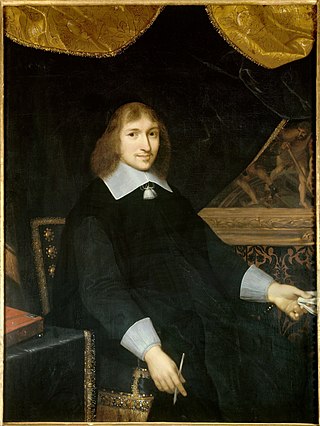
Nicolas Fouquet, marquis de Belle-Île, vicomte de Melun et Vaux was the Superintendent of Finances in France from 1653 until 1661 under King Louis XIV. He had a glittering career, and acquired enormous wealth. He fell out of favor, accused of peculation and lèse-majesté. The king had him imprisoned from 1661 until his death in 1680.
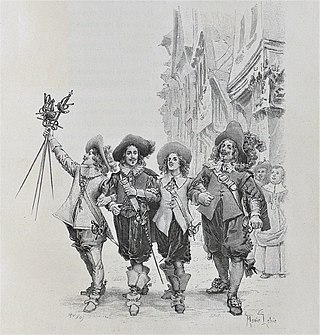
The Three Musketeers is a French historical adventure novel written in 1844 by French author Alexandre Dumas. As with some of his other works, he wrote it in collaboration with ghostwriter Auguste Maquet. It is in the swashbuckler genre, which has heroic, chivalrous swordsmen who fight for justice.

Porthos, Baron du Vallon de Bracieux de Pierrefonds is a fictional character in the novels The Three Musketeers (1844), Twenty Years After (1845), and The Vicomte de Bragelonne (1847–1850) by Alexandre Dumas, père. He and the other two musketeers, Athos and Aramis, are friends of the novel's protagonist, d'Artagnan. Porthos is a highly fictionalized version of the historical musketeer Isaac de Porthau.

Athos, Count de la Fère, is a fictional character in the novels The Three Musketeers (1844), Twenty Years After (1845) and The Vicomte de Bragelonne (1847–1850) by Alexandre Dumas, père. He is a highly fictionalised version of the historical musketeer Armand d'Athos (1615–1643).

The Man in the Iron Mask was an unidentified prisoner of state during the reign of King Louis XIV of France (1643–1715). Warranted for arrest on 28 July 1669 under the pseudonym of "Eustache Dauger", he was incarcerated on 24 August and held for 34 years in the custody of the same jailer, Bénigne Dauvergne de Saint-Mars, in four successive French prisons, including the Bastille. When he died there on 19 November 1703, his inhumation certificate bore the pseudonym of "Marchioly", leading several 19th century historians to conclude the prisoner was Italian diplomat Ercole Antonio Mattioli.

Charles de Batz de Castelmore, also known as d'Artagnan and later Count d'Artagnan, was a French Musketeer who served Louis XIV as captain of the Musketeers of the Guard. He died at the siege of Maastricht in the Franco-Dutch War. A fictionalised account of his life by Gatien de Courtilz de Sandras formed the basis for the d'Artagnan Romances of Alexandre Dumas père, most famously including The Three Musketeers (1844). The heavily fictionalised version of d'Artagnan featured in Dumas' works and their subsequent screen adaptations is now far more widely known than the real historical figure.

The Vicomte of Bragelonne: Ten Years Later is a novel by Alexandre Dumas. It is the third and last of The d'Artagnan Romances, following The Three Musketeers and Twenty Years After. It appeared first in serial form between 1847 and 1850.

Twenty Years After is a novel by Alexandre Dumas, first serialized from January to August 1845. A book of The d'Artagnan Romances, it is a sequel to The Three Musketeers (1844) and precedes the 1847–1850 novel The Vicomte de Bragelonne.
The Three Musketeers, the 1844 novel by author Alexandre Dumas, has been adapted into multiple films, both live-action and animated.

The Iron Mask is a 1929 American part-talkie adventure film directed by Allan Dwan. It is an adaptation of the last section of the 1847-1850 novel The Vicomte de Bragelonne by Alexandre Dumas, père, which is itself based on the French legend of the Man in the Iron Mask.

The Man in the Iron Mask is a 1998 American action drama film written, directed, and produced by Randall Wallace. It stars Leonardo DiCaprio in a dual role as the title character and the villain, Jeremy Irons as Aramis, John Malkovich as Athos, Gérard Depardieu as Porthos, and Gabriel Byrne as D'Artagnan. Some characters are from Alexandre Dumas's D'Artagnan Romances and some plot elements are very loosely adapted from his 1847-1850 novel The Vicomte de Bragelonne. This was Leonardo DiCaprio's first film following the success of Titanic (1997).

Paul Auguste Jean Nicolas Féval was a French adventure novelist, like his father Paul Féval, père. He was the third of eight children and the eldest son of Paul Féval, who was 42 years old and at the height of his success when Paul Féval fils was born.

The Man in the Iron Mask is a 1939 American historical adventure film very loosely adapted from the last section of the 1847–1850 novel The Vicomte de Bragelonne by Alexandre Dumas, père, which is itself based on the French legend of the Man in the Iron Mask.
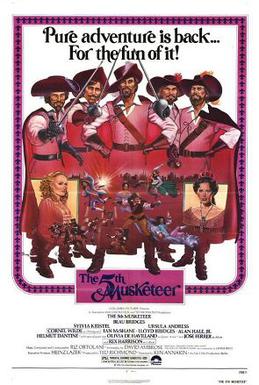
The Fifth Musketeer is a 1979 German-Austrian film adaptation of the last section of the 1847–1850 novel The Vicomte of Bragelonne: Ten Years Later by Alexandre Dumas, père, which is itself based on the French legend of the Man in the Iron Mask. It was released in Europe with the alternative title Behind the Iron Mask.

The Man in the Iron Mask is a 1977 television film loosely adapted from the 1847–1850 novel The Vicomte de Bragelonne by Alexandre Dumas and presenting several plot similarities with the 1939 film version. It was produced by Norman Rosemont for ITC Entertainment, and starred Richard Chamberlain as King Louis XIV and his twin Philippe, Patrick McGoohan as Nicolas Fouquet, Ralph Richardson as Jean-Baptiste Colbert, Louis Jourdan as D'Artagnan, and Ian Holm as the Chevalier Duval. Jenny Agutter plays Louis XIV's mistress, Louise de la Vallière. Vivien Merchant appears as Queen Marie-Therese. It was directed by Mike Newell.

The Three Musketeers is a 1986 Australian made-for-television animated adventure film from Burbank Films Australia. It is based on Alexandre Dumas's classic 1844 French novel, The Three Musketeers, and was adapted by Keith Dewhurst. It was produced by Tim Brooke-Hunt and featured original music by Sharon Calcraft.

Barbie and the Three Musketeers is a 2009 computer-animated fantasy film. It was released to DVD on September 15, 2009, and made its television premiere on Nickelodeon on November 22, 2009.
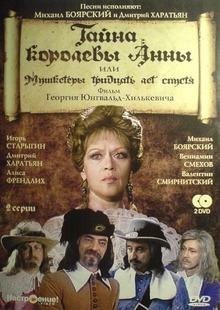
The Secret of Queen Anne or Musketeers Thirty Years After is a 1993 Russian swashbuckler film directed by Georgi Yungvald-Khilkevich based on Alexandre Dumas' 1847-1850 novel The Vicomte de Bragelonne.
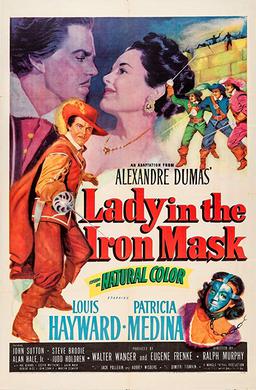
Lady in the Iron Mask is a 1952 American adventure film directed by Ralph Murphy, produced by Walter Wanger and starring Louis Hayward as D'Artagnan and Patricia Medina in the title role. Alan Hale, Jr. portrays Porthos, Judd Holdren plays Aramis, and Steve Brodie appears as Athos in this Three Musketeers adventure film, a reworking of Douglas Fairbanks' 1929 screen epic The Iron Mask, an adaptation of the last section of the 1847-1850 novel The Vicomte de Bragelonne by Alexandre Dumas, père, which is itself based on the French legend of the Man in the Iron Mask. The film's sets were designed by the art director Martin Obzina and shot in Supercinecolor.

Le secret du Masque de Fer is a historical essay by French novelist Marcel Pagnol, who identified the famous prisoner in the iron mask as the twin brother of Louis XIV, born after him and imprisoned for life in 1669 for having conspired against the King. The essay was published for the first time in 1965 under the title Le Masque de fer, and updated in 1973, completed in particular with research on James de la Cloche, identified as the twin bearing this name in his youth.


















